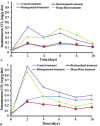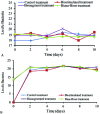In situ biosurfactant production and hydrocarbon removal by Pseudomonas putida CB-100 in bioaugmented and biostimulated oil-contaminated soil
- PMID: 24294259
- PMCID: PMC3833165
- DOI: 10.1590/S1517-83822013000200040
In situ biosurfactant production and hydrocarbon removal by Pseudomonas putida CB-100 in bioaugmented and biostimulated oil-contaminated soil
Abstract
In situ biosurfactant (rhamnolipid) production by Pseudomonas putida CB-100 was achieved during a bioaugmented and biostimulated treatment to remove hydrocarbons from aged contaminated soil from oil well drilling operations. Rhamnolipid production and contaminant removal were determined for several treatments of irradiated and non-irradiated soils: nutrient addition (nitrogen and phosphorus), P. putida addition, and addition of both (P. putida and nutrients). The results were compared against a control treatment that consisted of adding only sterilized water to the soils. In treatment with native microorganisms (non-irradiated soils) supplemented with P. putida, the removal of total petroleum hydrocarbons (TPH) was 40.6%, the rhamnolipid production was 1.54 mg/kg, and a surface tension of 64 mN/m was observed as well as a negative correlation (R = -0.54; p < 0.019) between TPH concentration (mg/kg) and surface tension (mN/m), When both bacteria and nutrients were involved, TPH levels were lowered to 33.7%, and biosurfactant production and surface tension were 2.03 mg/kg and 67.3 mN/m, respectively. In irradiated soil treated with P. putida, TPH removal was 24.5% with rhamnolipid generation of 1.79 mg/kg and 65.6 mN/m of surface tension, and a correlation between bacterial growth and biosurfactant production (R = -0.64; p < 0.009) was observed. When the nutrients and P. putida were added, TPH removal was 61.1%, 1.85 mg/kg of biosurfactants were produced, and the surface tension was 55.6 mN/m. In summary, in irradiated and non-irradiated soils, in situ rhamnolipid production by P. putida enhanced TPH decontamination of the soil.
Keywords: P. putida; bioremediation; irradiated soil; rhamnolipids; total petroleum hydrocarbons.
Figures





Similar articles
-
Evaluation of in situ biosurfactant production by inoculum of P. putida and nutrient addition for the removal of polycyclic aromatic hydrocarbons from aged oil-polluted soil.Biodegradation. 2022 Apr;33(2):135-155. doi: 10.1007/s10532-022-09973-2. Epub 2022 Jan 29. Biodegradation. 2022. PMID: 35092539
-
Efficient bioremediation of crude oil contaminated soil by a consortium of in-situ biosurfactant producing hydrocarbon-degraders.Sci Rep. 2025 Jun 5;15(1):19852. doi: 10.1038/s41598-025-05035-8. Sci Rep. 2025. PMID: 40473708 Free PMC article.
-
Biosurfactant-enhanced removal of total petroleum hydrocarbons from contaminated soil.J Hazard Mater. 2009 Aug 15;167(1-3):609-14. doi: 10.1016/j.jhazmat.2009.01.017. Epub 2009 Jan 16. J Hazard Mater. 2009. PMID: 19217712
-
Mitigation of petroleum-hydrocarbon-contaminated hazardous soils using organic amendments: A review.J Hazard Mater. 2021 Aug 15;416:125702. doi: 10.1016/j.jhazmat.2021.125702. Epub 2021 Mar 22. J Hazard Mater. 2021. PMID: 33866291 Review.
-
Basic principles for biosurfactant-assisted (bio)remediation of soils contaminated by heavy metals and petroleum hydrocarbons - A critical evaluation of the performance of rhamnolipids.J Hazard Mater. 2023 Feb 5;443(Pt A):130171. doi: 10.1016/j.jhazmat.2022.130171. Epub 2022 Oct 19. J Hazard Mater. 2023. PMID: 36367467 Review.
Cited by
-
Bioaugmentation and vermicompost facilitated the hydrocarbon bioremediation: scaling up from lab to field for petroleum-contaminated soils.Environ Sci Pollut Res Int. 2025 Jun;32(28):16601-16616. doi: 10.1007/s11356-024-32916-8. Epub 2024 Mar 22. Environ Sci Pollut Res Int. 2025. PMID: 38517632 Free PMC article.
-
Statistical and Artificial Neural Network Approaches to Modeling and Optimization of Fermentation Conditions for Production of a Surface/Bioactive Glyco-lipo-peptide.Int J Pept Res Ther. 2021;27(1):475-495. doi: 10.1007/s10989-020-10094-8. Epub 2020 Jul 22. Int J Pept Res Ther. 2021. PMID: 32837457 Free PMC article.
-
Co-production of lipases and biosurfactants by Bacillus methylotrophicus in solid-state fermentation.3 Biotech. 2024 Mar;14(3):78. doi: 10.1007/s13205-023-03910-7. Epub 2024 Feb 15. 3 Biotech. 2024. PMID: 38371903 Free PMC article.
-
The Role of pH, Electrodes, Surfactants, and Electrolytes in Electrokinetic Remediation of Contaminated Soil.Molecules. 2022 Oct 30;27(21):7381. doi: 10.3390/molecules27217381. Molecules. 2022. PMID: 36364207 Free PMC article. Review.
-
Biosurfactants during in situ bioremediation: factors that influence the production and challenges in evalution.Environ Sci Pollut Res Int. 2017 Sep;24(26):20831-20843. doi: 10.1007/s11356-017-9778-7. Epub 2017 Aug 16. Environ Sci Pollut Res Int. 2017. PMID: 28815413 Review.
References
-
- Aitken M, Stringfellow WT, Nagel R, Kazunga CH, Chen S. Characteristic of phenanthrene-degrading bacteria isolated from soils contaminated with polycyclic aromatic hydrocarbons. Can J Microbiol. 1998;44:743–752. - PubMed
-
- Amézcua-Allieri MA, Lead JR, Meléndez-Estrada J, Rodríguez-Vázquez R. Phenanthrene removal in selected mexican soils by the fungus Penicillium frequentans: Role of C:N ratio and water content. Soil Sediment Contam. 2003;12:387–399.
-
- Amézcua-Vega C, Ferrera-Cerrato R, Esparza García F, Ríos-Leal E, Rodríguez-Vázquez R. Effect of combined nutrients on biosurfactants produced by Pseudomonas putida. J Environ Sci Heal A. 2004;39:2983–2991. - PubMed
-
- Arce-Ortega JM, Rodríguez-Vázquez R, Rojas-Avelizapa NG. Identification of recalcitrant hydrocarbons present in drilling waste polluted soil. J Environ Sci Heal A. 2004;39:1535–1545. - PubMed
-
- Banks MK, Govindaraju RS, Schwab AP, Kulakow R, Finn J. Phytoremediation of Hydrocarbon-Contaminated Soil. Lewis Publishers CRC press LLC; USA: 2000.
Publication types
MeSH terms
Substances
LinkOut - more resources
Full Text Sources
Other Literature Sources
